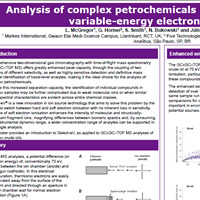
ANALYSIS OF COMPLEX PETROCHEMICALS BY GC×GC-TOFMS WITH VARIABLE-ENERGY ELECTRON IONISATION Chris Llewellyn (1), Júlio César (2) (1) Markes International, Gwaun Elai Medi-Sc |
Resumo do Pôster:Crude oil contains thousands of organic compounds ranging from light hydrocarbons to complex biomolecules. Speciation of hydrocarbons is of great interest to the petroleum industry, as certain isomers may have an adverse effect on engine performance if present in high quantities in the final fuel. Furthermore, chemical fingerprinting of crude oil has become extremely important for identification of those responsible for environmental contamination events. In the past, such complex samples were analysed by chemical fractionation followed by one-dimensional gas chromatography with mass spectrometry (GC–MS). However, fractionation is a time-consuming, labour-intensive process, which uses large volumes of solvents and can be prone to error. Two-dimensional gas chromatography coupled with time-of-flight mass spectrometry (GC×GC–TOF MS) is now used routinely in the oil industry to combat this problem. The coupling of two columns of different selectivity provides enhanced separation of complex mixtures, allowing all chemical classes to be monitored in a single analytical run. Despite the superior separation afforded by GC×GC, the identification of individual compounds in complex samples remains challenging when multiple compounds in a chemical class have similar spectra at conventional (70 eV) ionisation energies. Branched alkanes are a prime example, with weak molecular ions that further complicate the process. Spectral similarity can be addressed by the use of soft ionisation to reduce the degree of ion fragmentation, but this approach has been cumbersome to implement until now. In this study, we show how the problem of compound identification in petrochemical samples can be resolved without recourse to the time-consuming analysis of multiple standards. We achieve this by the application of Select-eV, a revolutionary MS source technology that enhances compound identification by enabling efficient electron ionisation at much lower (softer) energies without compromising sensitivity. We also show how Select-eV complements the other fundamental advantages of Markes’ BenchTOF time-of-flight mass spectrometers for the GC×GC identification of hydrocarbons. Variable-energy electron ionisation technology is also shown to enhance analyte speciation by providing additional data on both molecular ions and structurally significant fragments in the low-energy mass spectra. The enhanced sensitivity and selectivity stemming from the dramatic reduction in fragmentation at low energies also greatly increases the number of compounds identified, permitting robust statistical comparisons essential for successful chemical fingerprinting. |
